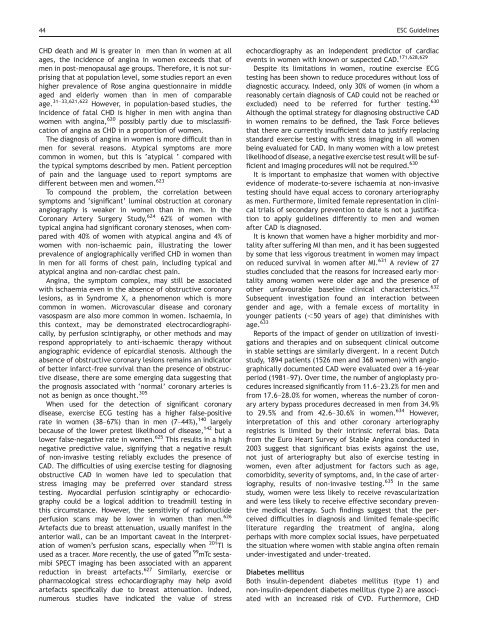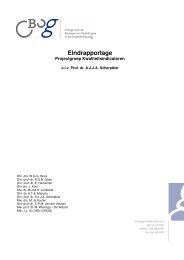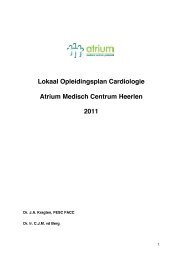Guidelines on the Management of Stable Angina Pectoris ... - Cardio
Guidelines on the Management of Stable Angina Pectoris ... - Cardio
Guidelines on the Management of Stable Angina Pectoris ... - Cardio
Create successful ePaper yourself
Turn your PDF publications into a flip-book with our unique Google optimized e-Paper software.
44 ESC <str<strong>on</strong>g>Guidelines</str<strong>on</strong>g>CHD death and MI is greater in men than in women at allages, <strong>the</strong> incidence <strong>of</strong> angina in women exceeds that <strong>of</strong>men in post-menopausal age groups. Therefore, it is not surprisingthat at populati<strong>on</strong> level, some studies report an evenhigher prevalence <strong>of</strong> Rose angina questi<strong>on</strong>naire in middleaged and elderly women than in men <strong>of</strong> comparableage. 31–33,621,622 However, in populati<strong>on</strong>-based studies, <strong>the</strong>incidence <strong>of</strong> fatal CHD is higher in men with angina thanwomen with angina, 620 possibly partly due to misclassificati<strong>on</strong><strong>of</strong> angina as CHD in a proporti<strong>on</strong> <strong>of</strong> women.The diagnosis <strong>of</strong> angina in women is more difficult than inmen for several reas<strong>on</strong>s. Atypical symptoms are morecomm<strong>on</strong> in women, but this is ‘atypical ’ compared with<strong>the</strong> typical symptoms described by men. Patient percepti<strong>on</strong><strong>of</strong> pain and <strong>the</strong> language used to report symptoms aredifferent between men and women. 623To compound <strong>the</strong> problem, <strong>the</strong> correlati<strong>on</strong> betweensymptoms and ‘significant’ luminal obstructi<strong>on</strong> at cor<strong>on</strong>aryangiography is weaker in women than in men. In <strong>the</strong>Cor<strong>on</strong>ary Artery Surgery Study, 624 62% <strong>of</strong> women withtypical angina had significant cor<strong>on</strong>ary stenoses, when comparedwith 40% <strong>of</strong> women with atypical angina and 4% <strong>of</strong>women with n<strong>on</strong>-ischaemic pain, illustrating <strong>the</strong> lowerprevalence <strong>of</strong> angiographically verified CHD in women thanin men for all forms <strong>of</strong> chest pain, including typical andatypical angina and n<strong>on</strong>-cardiac chest pain.<strong>Angina</strong>, <strong>the</strong> symptom complex, may still be associatedwith ischaemia even in <strong>the</strong> absence <strong>of</strong> obstructive cor<strong>on</strong>arylesi<strong>on</strong>s, as in Syndrome X, a phenomen<strong>on</strong> which is morecomm<strong>on</strong> in women. Microvascular disease and cor<strong>on</strong>aryvasospasm are also more comm<strong>on</strong> in women. Ischaemia, inthis c<strong>on</strong>text, may be dem<strong>on</strong>strated electrocardiographically,by perfusi<strong>on</strong> scintigraphy, or o<strong>the</strong>r methods and mayresp<strong>on</strong>d appropriately to anti-ischaemic <strong>the</strong>rapy withoutangiographic evidence <strong>of</strong> epicardial stenosis. Although <strong>the</strong>absence <strong>of</strong> obstructive cor<strong>on</strong>ary lesi<strong>on</strong>s remains an indicator<strong>of</strong> better infarct-free survival than <strong>the</strong> presence <strong>of</strong> obstructivedisease, <strong>the</strong>re are some emerging data suggesting that<strong>the</strong> prognosis associated with ‘normal’ cor<strong>on</strong>ary arteries isnot as benign as <strong>on</strong>ce thought. 305When used for <strong>the</strong> detecti<strong>on</strong> <strong>of</strong> significant cor<strong>on</strong>arydisease, exercise ECG testing has a higher false-positiverate in women (38–67%) than in men (7–44%), 140 largelybecause <strong>of</strong> <strong>the</strong> lower pretest likelihood <strong>of</strong> disease, 142 but alower false-negative rate in women. 625 This results in a highnegative predictive value, signifying that a negative result<strong>of</strong> n<strong>on</strong>-invasive testing reliably excludes <strong>the</strong> presence <strong>of</strong>CAD. The difficulties <strong>of</strong> using exercise testing for diagnosingobstructive CAD in women have led to speculati<strong>on</strong> thatstress imaging may be preferred over standard stresstesting. Myocardial perfusi<strong>on</strong> scintigraphy or echocardiographycould be a logical additi<strong>on</strong> to treadmill testing inthis circumstance. However, <strong>the</strong> sensitivity <strong>of</strong> radi<strong>on</strong>uclideperfusi<strong>on</strong> scans may be lower in women than men. 626Artefacts due to breast attenuati<strong>on</strong>, usually manifest in <strong>the</strong>anterior wall, can be an important caveat in <strong>the</strong> interpretati<strong>on</strong><strong>of</strong> women’s perfusi<strong>on</strong> scans, especially when 201 Tl isused as a tracer. More recently, <strong>the</strong> use <strong>of</strong> gated 99 mTc sestamibiSPECT imaging has been associated with an apparentreducti<strong>on</strong> in breast artefacts. 627 Similarly, exercise orpharmacological stress echocardiography may help avoidartefacts specifically due to breast attenuati<strong>on</strong>. Indeed,numerous studies have indicated <strong>the</strong> value <strong>of</strong> stressechocardiography as an independent predictor <strong>of</strong> cardiacevents in women with known or suspected CAD. 171,628,629Despite its limitati<strong>on</strong>s in women, routine exercise ECGtesting has been shown to reduce procedures without loss <strong>of</strong>diagnostic accuracy. Indeed, <strong>on</strong>ly 30% <strong>of</strong> women (in whom areas<strong>on</strong>ably certain diagnosis <strong>of</strong> CAD could not be reached orexcluded) need to be referred for fur<strong>the</strong>r testing. 630Although <strong>the</strong> optimal strategy for diagnosing obstructive CADin women remains to be defined, <strong>the</strong> Task Force believesthat <strong>the</strong>re are currently insufficient data to justify replacingstandard exercise testing with stress imaging in all womenbeing evaluated for CAD. In many women with a low pretestlikelihood <strong>of</strong> disease, a negative exercise test result will be sufficientand imaging procedures will not be required. 630It is important to emphasize that women with objectiveevidence <strong>of</strong> moderate-to-severe ischaemia at n<strong>on</strong>-invasivetesting should have equal access to cor<strong>on</strong>ary arteriographyas men. Fur<strong>the</strong>rmore, limited female representati<strong>on</strong> in clinicaltrials <strong>of</strong> sec<strong>on</strong>dary preventi<strong>on</strong> to date is not a justificati<strong>on</strong>to apply guidelines differently to men and womenafter CAD is diagnosed.It is known that women have a higher morbidity and mortalityafter suffering MI than men, and it has been suggestedby some that less vigorous treatment in women may impact<strong>on</strong> reduced survival in women after MI. 631 A review <strong>of</strong> 27studies c<strong>on</strong>cluded that <strong>the</strong> reas<strong>on</strong>s for increased early mortalityam<strong>on</strong>g women were older age and <strong>the</strong> presence <strong>of</strong>o<strong>the</strong>r unfavourable baseline clinical characteristics. 632Subsequent investigati<strong>on</strong> found an interacti<strong>on</strong> betweengender and age, with a female excess <strong>of</strong> mortality inyounger patients (,50 years <strong>of</strong> age) that diminishes withage. 633Reports <strong>of</strong> <strong>the</strong> impact <strong>of</strong> gender <strong>on</strong> utilizati<strong>on</strong> <strong>of</strong> investigati<strong>on</strong>sand <strong>the</strong>rapies and <strong>on</strong> subsequent clinical outcomein stable settings are similarly divergent. In a recent Dutchstudy, 1894 patients (1526 men and 368 women) with angiographicallydocumented CAD were evaluated over a 16-yearperiod (1981–97). Over time, <strong>the</strong> number <strong>of</strong> angioplasty proceduresincreased significantly from 11.6–23.2% for men andfrom 17.6–28.0% for women, whereas <strong>the</strong> number <strong>of</strong> cor<strong>on</strong>aryartery bypass procedures decreased in men from 34.9%to 29.5% and from 42.6–30.6% in women. 634 However,interpretati<strong>on</strong> <strong>of</strong> this and o<strong>the</strong>r cor<strong>on</strong>ary arteriographyregistries is limited by <strong>the</strong>ir intrinsic referral bias. Datafrom <strong>the</strong> Euro Heart Survey <strong>of</strong> <strong>Stable</strong> <strong>Angina</strong> c<strong>on</strong>ducted in2003 suggest that significant bias exists against <strong>the</strong> use,not just <strong>of</strong> arteriography but also <strong>of</strong> exercise testing inwomen, even after adjustment for factors such as age,comorbidity, severity <strong>of</strong> symptoms, and, in <strong>the</strong> case <strong>of</strong> arteriography,results <strong>of</strong> n<strong>on</strong>-invasive testing. 635 In <strong>the</strong> samestudy, women were less likely to receive revascularizati<strong>on</strong>and were less likely to receive effective sec<strong>on</strong>dary preventivemedical <strong>the</strong>rapy. Such findings suggest that <strong>the</strong> perceiveddifficulties in diagnosis and limited female-specificliterature regarding <strong>the</strong> treatment <strong>of</strong> angina, al<strong>on</strong>gperhaps with more complex social issues, have perpetuated<strong>the</strong> situati<strong>on</strong> where women with stable angina <strong>of</strong>ten remainunder-investigated and under-treated.Diabetes mellitusBoth insulin-dependent diabetes mellitus (type 1) andn<strong>on</strong>-insulin-dependent diabetes mellitus (type 2) are associatedwith an increased risk <strong>of</strong> CVD. Fur<strong>the</strong>rmore, CHD














